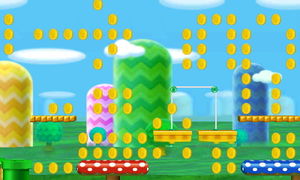Golden Plains
| Golden Plains | |
|---|---|
 File:MarioSymbol.png | |
| Universe | Mario |
| Appears in | SSB4 (3DS) |
| Availability | Starter |
| Tracks available | Athletic / Ground Theme (New Super Mario Bros. 2) Ground Theme / Underground Theme (Super Mario Bros.) (Alternate) |
| Article on Super Mario Wiki | World 1 (New Super Mario Bros. 2) |
Golden Plains[1] (野原, Fields) is a stage in Super Smash Bros. for Nintendo 3DS. The stage features many coins for fighters to collect.
Overview
In this stage, several elements from the New Super Mario Bros. series appear, including thin platforms, scale-like platforms which will tilt (and potentially fall) when stood on, flat-top hills to stand on, and bottomless pits. Throughout the stage there are many coins for fighters to collect, and by collecting 100 of these, a fighter temporarily becomes a gold version of themselves called a "Gold Fighter". Gold Fighters have stronger attacks and do not flinch from opponents' attacks. The number of coins the player has is displayed in the top-left corner of the screen; each player will only see their own count and not their enemies'.
Sometimes, an arrow signpost will appear and the screen will scroll in the direction the arrow points, bringing the fighters to a new area of the stage.
Origin
Golden Plains is based on World 1-1 of New Super Mario Bros. 2. A major challenge of the game was to collect coins, introdcing a power-up called the Gold Flower, which would transform Mario or Luigi into supermariowiki:Gold Mario/Luigi which could transform enemies into coins by shooting golden fireballs. Coins were originally introduced in Mario Bros. as a point-giving item, and in most Mario games since Super Mario Bros. will collecting 100 coins reward the player with an extra life. Super Mario 64 later on introduced two new types of coins: Red Coins and Blue Coins. Collecting a red coins would be the equivalent of two Yellow Coins (as normal coins were called in that game) and collectin eight would award the player with one Power Star per level, while Blue Coins was the equivalent of five Yellow Coins and only appeared from specific Blue Coin Blocks. In the New Super Mario Bros. games, eight Red Coins per level would appear from Red Rings and award the player with an extra life if all were collected within the time limit, and Blue Coins would appear by pressing a P-Switch. The music played originally appeared in the same scenarios in New Super Mario Bros., while the coin counter font first appeared in Super Mario 3D Land.
P-Switches originally appeared in Super Mario Bros. 3, where they would transfer Brick Blocks into coins and vice versa. The same goes for the spiked platforms, which occasionally would house hidden power-ups.
Another feature introduced in Mario Bros. where horizontal warp pipes the enemy would come out of. Super Mario Bros. introduced horizontal warp pipes, aswell as warp pipes usable by Mario and Luigi, a standard feature in later games. Several in their New Super Mario Bros.-appearance can be seen in this stage. Super Mario Bros. in itself introduced introduced falling platforms and mushroom platforms; while the falling platforms have been only aesthetically changed since the original game and functions like they did in the stage Mushroom Kingdom stage in the original Super Smash Bros. and it's redesigned correspondent in Super Smash Bros. Melee, the mushroom platforms do not. Whereas Super Mario Bros. featured yellow-colored mushrooms with red dots, it was not until the game was remade for Super Mario All-Stars that red-colored ones with white dots were introduced. Blue-colored mushrooms with white dots first appeared in Mario Party minigame, before becoming a staple in New Super Mario Bros. where they were used as bouncing platforms. In Golden Plains, they are stationary like in Mario Party.
Gallery
Samus as a Gold Fighter.
Samus, Luigi and Little Mac fighting.




